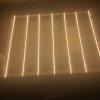It was Eisenstein and Planck that says ISL works. I only verified it works when my measured values match my calculated values.
Like alesh explained, inverse square does apply to point light sources free to spread their light around. That was however not the case we were discussing.
The argument was about fixture distance to canopy. Which means with multiple light points causing overlap and hung inside reflective walls. By the nature of the application the light is also well within the distance where "ISL" is negated.
The only thing your simulation showed is that indeed "ISL" applies per light point, but at the same time the outcome clearly showed that "ISL" does NOT apply for the combination of those light points. The latter was what the discussion was actually about. So you have effectively proven that you are wrong.
Moreover, even IF you were right that ISL applies to fixture to canopy distance, the amount of light you'd need to be able to hang a light at 40" and still get 500umol/s/m2 at the canopy level is staggering. You'd need 64 times (40/5=8^2=64) the amount of light to start with. So for 500umol/s over a square meter you'd need about 200W from a light at 5", but to hang it at 40" and to then still get the same 500umol/s over that m2 after applying "ISL" you would need a 12800W fixture. Brilliant really.
Whatever you now pretend you made those tables for, they are completely useless when you don't show how much light you need to start with to get the selected light level at the canopy.
Apart from the fact that those tables are completely wrong to begin with since "ISL" does not apply to fixture to canopy distance at all.
You are a troll that attacks whoever you find a threat to exposing your ignorance and protect your boyfriends that sell good based on bullshit and fabricated "facts".
There is at least a dozen people trying to get you to understand how wrong you are on just about everything. You can pretend they are all my "boyfriends", but perhaps you should finally try to get over your cognitive dissonance and see that you are indeed the one who is wrong.
You took measurements and it showed a straight line. How on earth can you conclude from this straight line that "ISL" applies just because the intensity decrease on the last two points is "only" 11% different from what "ISL" would show? Again, here is a a chart of YOUR measurements:

You keep jammering on about how ISL only applies from a distance 5 times greater than the light is wide (because of overlap).
ISL will work on the entire fixture if there is enough distance between the sensor and the fixture to meet the five times rule. Even 3x distance is fairly accurate. 10 feet works well for fixtures under 3' wide or long.
So who hangs their light at 10 feet? How can you not understand that when it's less than 10 feet "ISL" does not apply to fixture height?
ISL says that light spreads over an area which grows at a quadratic pace with distance. How can you not understand that if you reflect the light back into a confined area that this does not apply anymore? That then the only loss of light you experience is due to light absorbed by the walls (due to lower than 100% reflectance of the wall material).
This is not about ISL being something that exists in general, but specifically about the distance between the fixture and plant canopy. Just like you measured and like you display in those penetration tables.
It's just staggering how easy it should be to see that you are wrong. Everybody here does, but you.


